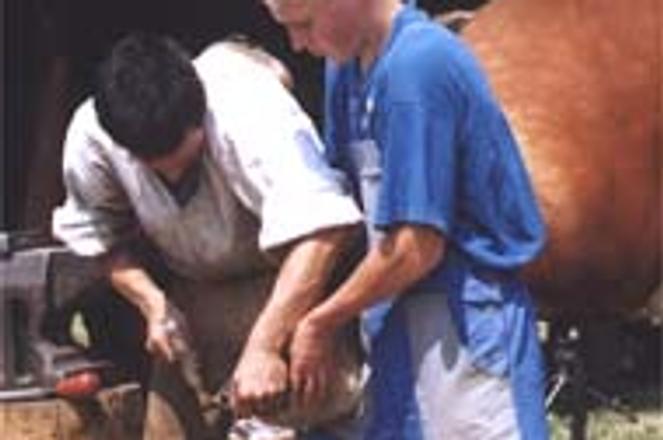A blacksmith shoes a horse at the European Folk Craft festival in Kežmarok from July 13 to 15.photo: Zuzana Habšudová
KEŽMAROK: A crowd of 15 circled blacksmith Boris Michalík as he beat a red-hot piece of iron. The metal sizzled as it was tossed in a bucket of water, crackled in the fire, and clanged under the blows of Michalík's hammer. Five cycles later it emerged - to the amazement of the crowd - a functional horseshoe.
The blacksmith trade, one of 50 on display at the European Folk Craft festival in Kežmarok July 13 to 15, has a rich heritage in Slovakia. Yet it is unlikely that many more generations will witness it, say festival organisers and blacksmiths themselves. Once a mainstay of the country's economy, the blacksmith - like most of the other 200 artisans who gathered in this northern Slovak city - has become a dying breed.
In centuries past, every Slovak village had a blacksmith. But following World War II, farms were collectivised and newly-built factories boosted the country's industrial production. By 1948, industry had doubled its production from 1937; by 1964, industry employed more Slovaks than did agriculture for the first time in history. Textile plants made dressmakers and weavers redundant. Ploughs replaced horses, reducing the demand for blacksmiths to almost nothing.
Today there are less than 30 traditional blacksmiths in Slovakia, according to UĽUV, an association of Slovak trades.
"I chose to be a blacksmith because of the state of mind it brings," said Michalík, gesturing with blackened, sinewy hands. "I've had spiritual experiences with the hammer in my hand I can't put into words. But I don't know if I'll be able to make a living at it my whole life."
The demise of the blacksmith trade has been felt in scores of others, from candle-making and wood-carving to pottery and weaving, said Kežmarok historian Norá Baráthová.
"This year at the festival there are two women who still make linen from flax," she said. "One is over 80 and the other is in her 70s. I doubt anybody else in Slovakia knows how to work with flax."
Now in its 10th year, the festival aims to preserve such obsolescent trades, drawing thousands of visitors spending thousands of crowns. But as the only gathering of its kind in Slovakia, it's hardly enough to support the artisans for an entire year.
Michalík struggled to find work after graduating in a class of seven in 1998 from a vocational school at western Slovakia's Dubnica nad Váhom, one of only three such schools in the country that teach traditional blacksmithing. He recently found full-time employment in a small firm and now spends upwards of 70 hours a week with hammer and anvil to make ends meet.
"I live with my parents still and don't have anything of my own," he said. "You can survive as a blacksmith in Slovakia, but it's a life of poverty."
Prospects are better for those practising traditional artistic crafts, in part because of the onset of tourism since the 1989 revolution. Still, the outlook of the crafts themselves is bleak. Making hand-sized dolls from corn husks, 60-year-old Mária Katušová ekes out a living selling the dolls for around 100 Slovak crowns ($2) in High Tatra gift shops and on Bratislava's Main Square.
But the work is more demanding, she says, than most people realise. Katušová spends a full month each year gathering 20 large sacks of husks, which she washes and dries by hand. In all she earns about 30 crowns per hour - not enough, she says, to attract Slovakia's youth to the age-old trade.
"Four girls once asked me if I could teach them how to make the dolls," said Katušová. "I explained to them what was involved and never heard from them again." Roughly 50 Slovaks know how to make corn-husk dolls, Katušová added, and most are nearing or are past retirement age.
To stay competitive in today's economy, some craftsmen have corrupted traditional techniques to boost efficiency and consumer appeal.
"I prefer doing as much as possible by hand, but it's not always possible," said Michálik. "My neighbour [on the festival grounds] was selling [machine-made] spiral decorations for 40 crowns. If I wanted to make something like that by hand, I would have to sell it for 600 crowns. Who would buy it?"
In fact, at the festival only about 5% of the crafts were created using strictly the techniques of centuries past, estimated Baráthová.
"Slovak tinkers used to travel throughout Europe fixing almost anything with wire," said Baráthová. "Now I see only people selling wire rings, Christmas ornaments and other trinkets. Those are not the old traditions."

